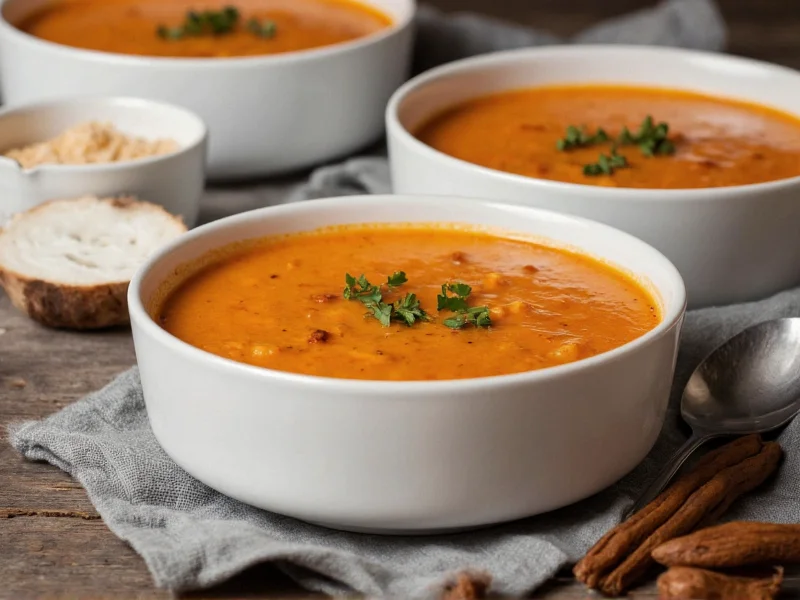When temperatures drop, nothing satisfies like a steaming bowl of soup. The science behind this universal comfort food choice is straightforward: warm liquids raise your core body temperature faster than solid foods, while the combination of vegetables, proteins, and complex carbohydrates provides sustained energy to combat winter chill. Research shows that consuming warm meals during cold weather can improve circulation and boost mood through the release of serotonin.
Why Certain Soups Excel in Cold Weather
Cold weather demands specific nutritional properties that ordinary soups might not deliver. The most effective winter soups share these critical characteristics: high broth content for hydration, substantial protein sources for sustained energy, and complex carbohydrates that digest slowly. Unlike lighter summer soups, cold-weather varieties benefit from longer cooking times that develop deeper flavors and extract maximum nutrients from ingredients.
| Soup Type | Key Warming Ingredients | Preparation Time | Nutritional Benefits |
|---|---|---|---|
| Beef Stew | Chuck roast, potatoes, carrots, onions | 2.5-3 hours | High protein, iron, vitamin A |
| Chicken Noodle | Chicken thighs, egg noodles, celery, carrots | 1.5 hours | Collagen, electrolytes, vitamin B |
| Lentil Soup | Green lentils, tomatoes, spinach, garlic | 45 minutes | Fiber, folate, magnesium |
| Tomato Basil | Tomatoes, fresh basil, garlic, olive oil | 30 minutes | Lycopene, antioxidants, vitamin C |
Top 4 Soup Categories for Cold Weather
1. Hearty Meat-Based Stews
Beef bourguignon and lamb stew represent the pinnacle of cold-weather comfort foods. These substantial soups work through multiple mechanisms: the high protein content requires more energy to digest (thermic effect), generating internal warmth. The collagen from bone-in meats supports joint health—particularly valuable when cold weather exacerbates arthritis. For optimal results, brown meats thoroughly before simmering to develop complex flavor compounds through the Maillard reaction.
2. Creamy Vegetable Soups
Potato leek and butternut squash soups provide exceptional warmth without heavy meats. The natural starches in root vegetables create a velvety texture that coats the throat, providing immediate comfort. Professional chefs recommend roasting vegetables before blending to caramelize natural sugars, enhancing both flavor and the soup's warming properties. These comforting cold weather soup ideas deliver substantial nutrition while remaining vegetarian-friendly.
3. Legume and Grain Varieties
Lentil, bean, and barley soups offer remarkable cold-weather benefits through their high fiber content. Fiber slows digestion, creating sustained energy release that combats the energy crashes common in winter. The complex carbohydrates in these soups stabilize blood sugar while providing long-lasting warmth. For best results, soak dried beans overnight to reduce cooking time and improve digestibility—a crucial consideration when your body is already working harder to maintain temperature.
4. Broth-Based Classics
Chicken noodle soup transcends cliché as a scientifically validated cold-weather remedy. Studies confirm that the steam from hot chicken broth reduces nasal congestion, while the amino acid cysteine in chicken may help thin mucus. For maximum therapeutic effect, include garlic and ginger—both contain compounds that improve circulation and generate internal heat. These best soups for cold days require minimal ingredients but deliver maximum comfort.
Essential Ingredients for Maximum Warmth
Certain ingredients naturally enhance a soup's warming properties. Ginger contains gingerol, which increases circulation and creates a sensation of warmth. Cayenne pepper's capsaicin triggers thermogenesis, literally making your body produce more heat. Root vegetables like sweet potatoes and parsnips store summer energy that translates to substantial calories when consumed. When developing your warming soup recipes for winter, incorporate at least two of these heat-enhancing ingredients for optimal effect.
Perfecting Your Cold Weather Soup Technique
Professional chefs emphasize three critical techniques for superior winter soups. First, build flavor layers by sautéing aromatics (onions, celery, carrots) before adding liquids. Second, maintain a gentle simmer rather than vigorous boil to prevent ingredient breakdown while allowing flavors to meld. Third, finish with fresh herbs and a touch of acid (lemon juice or vinegar) to brighten rich flavors. These easy cold weather soup preparation methods transform simple ingredients into extraordinary comfort food.
Nutritional Advantages During Cold Months
Nutritious winter soup recipes address specific seasonal nutritional challenges. The steam from hot soups hydrates mucous membranes, reducing winter dryness. The high vegetable content delivers vitamins often lacking in winter diets. The warmth encourages slower eating, improving digestion and satiety. Most importantly, the combination of fluids and electrolytes in soups helps maintain proper hydration—a frequently overlooked aspect of winter health when people drink less water in cold weather.
Storage and Reheating for Maximum Enjoyment
Traditional cold weather soup varieties often taste better after flavors have melded overnight. For optimal storage, cool soups rapidly by placing the pot in an ice bath before transferring to airtight containers. Most soups maintain quality for 4-5 days refrigerated or up to 3 months frozen. When reheating, add a splash of broth or water to restore ideal consistency, and always heat to 165°F (74°C) for food safety. The convenience of having ready-to-eat warming meals makes these soup preparations invaluable during busy winter months.











 浙公网安备
33010002000092号
浙公网安备
33010002000092号 浙B2-20120091-4
浙B2-20120091-4